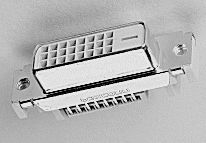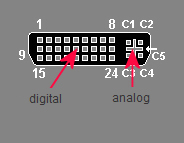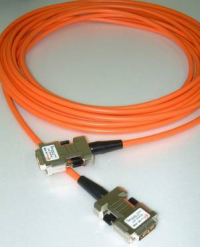
DVI is an open industry specification, which enables high-performance and robust interfacing solutions for high-resolution digital displays. DVI replaces analog technology such as VGA. The specification was introduced by the Digital Display Working Group (DDWG) as DVI 1.0 in April 1999.
Designed to transfer uncompressed real-time digital video, DVI supports PC graphics resolutions beyond 1600x1200 and HDTV resolutions, including 720p, 1080i, and 1080p.
Data is transmitted by the transition minimized differential signaling (TMDS) protocol. The DVI specification calls for at least one TMDS link which includes three data channels (RGB) and one clock control channel. Channel 0, 1 and 2 are used for video and audio data. Channels 3 is used for clock data.
DVI Specification 1.0: a single TMDS link may operate at up to 165MHz that offers 1.65Gbps of bandwidth.
This bandwidth corresponds to 165 Million pixels with 24bit color depth per second > UXGA resolution of 1600x1200 with 60Hz refresh tare and CTR blanking. Dual Link DVI has a maximum bandwidth of 2 x 165 MHz = 330 MHz, 3.30Gbps.

 |
 |
 |
| DVI-I (digital and analog) | DVI-D (digital only) |
| DVI Type | Signal Type | Number of Pins |
| DVI-D | digital only - 24 pins (3 rows of 8 pins) | 24 pins |
| DVI-I | digital and analog - 24 pins plus 5 (for analog RGBHV) | 24 pins plus 5 for analog (RGBHV) |
| Dual Link | dual link DVI supports 2x165 MHz (2048x1536 at 60 Hz, 1920x1080 at 85 Hz) | 24 pins |
| Single Link | single link DVI supports a maximum bandwidth of 165 MHz (1920x1080 at 60 Hz, 1280x1024 at 85Hz) | 24 pins |
| Pin | Description |
| 1 | TMDS Data2- |
| 2 | TMDS Data2+ |
| 3 | TMDS Data2 Shield |
| 4 | No Connection |
| 5 | No Connection |
| 6 | DDC Clock |
| 7 | DDC Data |
| 8 | Analog Vertical Sync |
| 9 | TMDS Data1- |
| 10 | TMDS Data2+ |
| 11 | TMDS Data1 Shield |
| 12 | No Connection |
| 13 | No Connection |
| 14 | +5 V Power |
| 15 | Ground (for +5 V) |
| 16 | Hot Plug Detect |
| 17 | TMDS Data0- |
| 18 | TMDSData0+ |
| 19 | TMDS Data0Shield |
| 20 | No Connection |
| 21 | No Connection |
| 22 | TMDS Clock Shield |
| 23 | TMDS Clock + |
| 24 | TMDS Clock - |
| C1 | Analog Red |
| C2 | Analog Green |
| C3 | Analog Blue |
| C4 | Analog Horizontal Sync |
| C5 | Analog Ground (analog R, G & B return) |
DVI and HDMI signals are basically compatible. DVI will carry all HDMI signal components that are covered by the DVI standard and HDMI will carry all DVI signal components that are covered by the HDMI standard. Most significant difference: HDMI carries audio channels and all the new features of HDMI 1.4 are not covered by DVI.

With DVI, HDCP (high definition content protection) was introduced by the entertainment industry. It is a "key" encoded into the DVI signal that prevents video data piracy.
If a source is HDCP coded and connected via DVI without the proper HDCP decoding, the picture is put into a "snow vision" mode or changed to a low resolution. For normal content distribution the source and the display device must be enabled for HDCP "software key" decoding.
